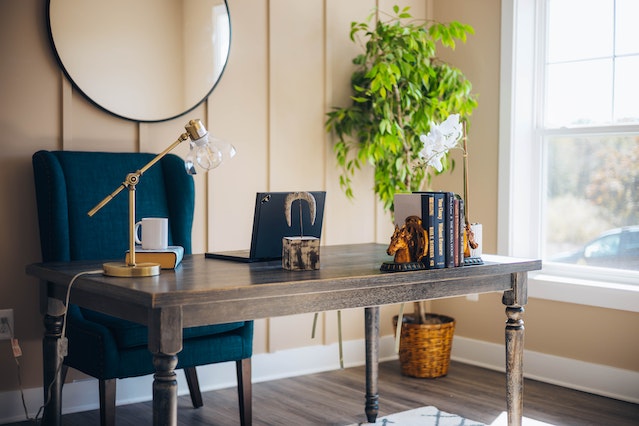How to design an inspiring Home Office
Introduction
These are the key points that you need to think about to design a home office that nurtures high productivity during working hours, and a stress-free ambiance.
- Room size
- Window and desk location
- Clutter free furniture
- Lighting
- Smart technology
1. The room size is important
Working from home is now a lifestyle choice for most working age people. In the past a home office might have been an afterthought for a disused space in the house where the family put their inkjet printer, and a budget computer desk. Now, a home office is an essential consideration for property buyers. Even if your house doesn’t have a well-designed space, the size of the room needs to inspire potential.
You need to assign a moderately sized room for a home office because of several key sizeable furniture: sturdy desk, ergonomic chair, bookshelf and storage.
An inviting room needs a balance of function and space. You should not fill all available walls with furniture. Instead, I would recommend that you leave an side or corner free, as this will add a calming atmosphere. You can decorate it with mellow wall art, or grow a leafy house plant. If space permits, you can even make it a “break-out area” with bean bags and coffee table.
If the room is not large, there should be enough space in the middle of the room for you to walk about or stretch. I would recommend keeping the centre of the room as empty as you can such as placing an L-shaped desk against a corner rather than centrally. For large rooms, you can explore having your work station set up in the middle of the room and more empty wall spaces.
Choose a room that does not have a low ceiling. The higher the ceiling, the less stressful the room feels. However, for taller ceilings, please ensure that there is enough heating so during winter the space remains warm. I would recommend carpet or rug flooring to trap more heat on the ground.

2. Window location and desk position
The room you choose as a home office should have a window so your work day is graced with natural light. Studies have shown that natural white light can boost mind focus and productivity. Your desk should be placed so that natural light can shine indirectly onto the surface without being blocked by shadows.
I would recommend that you do not place the desk directly in front of a south facing window because working under direct sunlight can be extremely uncomfortable during the summer. Alternatively, please consider a translucent blind that can prevent over-exposure to UV rays.
You should be aware that no matter how much sunlight you soak in behind a window, the glass blocks out UV-B rays needed to stimulate your body to make Vitamin D. You can boost your Vitamin D with organic supplements, and I highly recommend this during winter season.

3. Don't clutter the room
When it comes to furnishing your home office, less is more. over-crowding the room with storage spaces and shelves can be distracting, particularly if you clutter it with miscellaneous artifacts. I would recommend that when you sit down to work, there are no exposed shelves in your line of sight. Place these at the wall or corner behind you.
The style and colour of the furniture is as important as its functionality. A well considered design scheme will invite you in, and make a pleasing place to spend seven or eight hours each day.
It is crucial that your home office has creative elements to break the corporate monotony, and inspire productivity. Please consider house plants big and small, and a few ornaments or artwork.

4. Adequate lighting
At some point during the day you will need to switch on the light, especially if the home office room has only a small window. Compared to the rest of the house, your home office light should be brighter (measured in lumens), and whiter (measured in Kelvin). Go for LED bulbs as they have a longer lifespan and more energy efficient. This is between 300 to 500 lumens, and 3000 to 5000 Kelvins.
It is best to configure the light source so it shines evenly in the room. If you want a focus light, then invest in an LED desk lamp.

5. Smart technology
The gadgets you should have in the home office is defined by the nature of your work. You should not have non-essential equipment or accessories in the room. However, I would recommend the following useful features, and smart technologies for your home office that will boost your productivity:
- Automatic standing desk
- Ergonomic swivel chair, with a sturdy lumbar support.
- Desk extension leads with USB sockets.
- Large monitor display and brackets.
- Wireless signal booster.
- Portable electric heater and fan
- Noise-reducing microphone and headset
- Cold water dispenser
Gadgets that should not be kept in the home office include multi-colour smart light bulbs, TV, robot vacuum cleaners, and smart assistant devices.
Conclusion
There are plenty of design ideas you can brainstorm for a home office, and keeping to these 5 essential guidance will ensure that your creation will be both aesthetically pleasing, and highly purposeful as a productive work space. If you have a design in mind for desks and chairs, check out my review of these highly regarded products based on design, functionality, quality and customers’ feedback.
